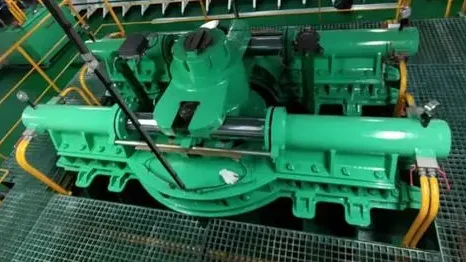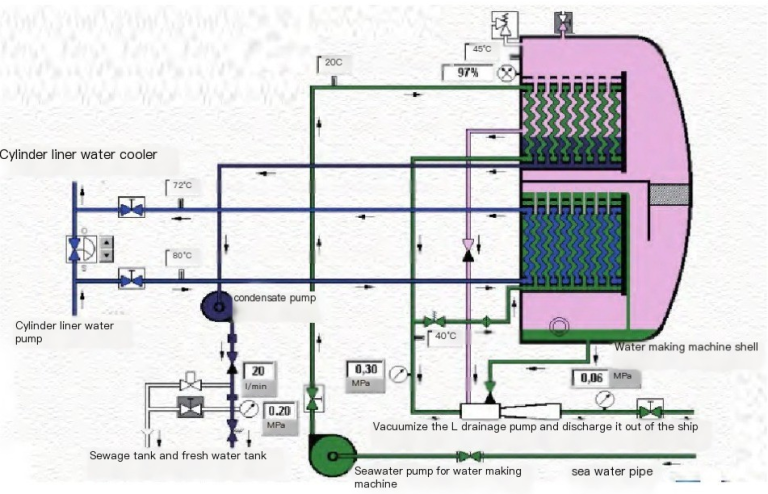Combined with equipment maintenance examples, this paper first analyzes the possible causes of the fault, and then accurately locates the fault through the investigation of the working principle of each component and the cause of the fault, and solves the problem of abnormal loss of oil replenishment pressure of the auxiliary pump of the hydraulic steering gear.

1. Fault phenomenon, cause analysis and elimination
1.1 Fault phenomenon
When a ship is navigating at high speed, when the right unit of the hydraulic steering gear operates to turn the rudder, an abnormal sound is emitted, presenting a sharp and piercing noise.
Observing the hydraulic system, it was found that when the rudder was turned to the left, the oil replenishment pressure was out of pressure (the normal set pressure was 1MPa, the instantaneous pressure was 0, and it returned to normal after about 1 s), and the outlet pipeline of the main pump had a feeling of holding pressure, and the sound was obviously sharp and harsh at this time; When you turn the rudder to the right, the pressure, the sound is normal.
1.2 Working principle
The hydraulic system of the ship’s steering gear is divided into two oil circuits, namely auxiliary oil circuit and main oil circuit.
For the sake of convenience, take the left unit work as an example to illustrate the working principle of hydraulics.
1) Auxiliary oil circuit.
One of the double vane pumps, that is, the oil discharged with a flow rate of 32L/min, is filtered through the oil filter, and the hydraulic oil is replenished to the main pump through a check valve.
The other way is the oil discharged with a flow rate of 25L/min, which is filtered through the oil filter and connected to the cooling oil port of the main pump for cooling.
2) Main oil circuit.
There is no signal from the rudder at the autopilot, and the swash plate of the main pump is in the zero position.
Although the oil pump rotates, it does not drain the oil (the oil circuit of the main pump is connected through the zero bypass valve on the oil pump).
After receiving the instruction (the zero bypass valve isolates the inlet and outlet of the oil pump), it is assumed that the pipeline above the main pump is the oil outlet pipe, which is divided into two ways through the left balance valve, and enters the 1# cylinder all the way to turn the rudder to the left;
The other way into the 3# cylinder through the isolation bypass valve also turns the rudder to the left.
Because there is a tie rod between the two tillers, the two rudders rotate synchronously.
The oil return of the 2# cylinder also returns to the suction port of the main pump through the balance valve, because there is a balance valve to cut off the oil circuit leading to the right main pump, so the right main pump is not used as a hydraulic output pump.
1.3 Fault analysis and elimination
When sailing, the water flow produces a certain pressure on the rudder blade, the servo has the corresponding load. When turning the rudder to the left, the auxiliary pump oil supply pressure instantly drops to zero, from the oil supply pressure combined with the hydraulic system principle analysis, the reasons for the failure are as follows:
(1) The loss of hydraulic oil in the main oil circuit is too large, and the hydraulic oil of the auxiliary pump is too late to replenish the oil;
(2) The displacement of the auxiliary pump is too low, and the oil replenishment volume is less than the loss of hydraulic oil in the main oil circuit;
(3) The oil return of the closed hydraulic system is not smooth.
According to the above three fault causes, the structural analysis and problem troubleshooting of related parts and components are carried out.
1) The hydraulic oil relief valve of the auxiliary pump is damaged.
The oil replenishment relief valve adopts a direct-acting relief valve, which is composed of adjusting screws, nuts, springs, valve bodies, valve seats, and valve cores.
Its function is to release the oil when the oil pressure of the system in front of the valve exceeds the fixed value of the whole number, so as to keep the oil pressure in front of the valve not exceeding a certain value or keep the oil pressure basically stable.
If the spring is broken or the stiffness is not good, the contact surface between the valve core and the valve seat is not good, the valve core and the valve body are brushed, and the valve core damping core is blocked, etc., it will cause the relief valve to be inflexible, and the hydraulic oil from the auxiliary pump leaks through the relief valve, and the leakage is too large, and it is too late to replenish the oil to the main hydraulic system.
Disassemble the oil fill relief valve, carefully clean each part with cleaning agent and inspect it:
The spring is not broken, and the spring stiffness is normal;
There are no defects such as abnormal wear, notch, and brushing of the valve core and valve seat;
The spool damping hole is not blocked. Indicates that the relief valve is working properly.
2) The oil filling hydraulic filter element is clogged.
The filter element of the oil replenishment hydraulic system is a paper material, if it is blocked, it will cause the hydraulic oil from the auxiliary pump to the main pump to be unblocked, and the internal leakage of the main pump is greater than the oil replenishment amount.
When the system is working normally, observe the differential pressure gauge of the filter element, and the differential pressure is 0.05 MPa, indicating that the filter element is not dirty and blocked.
In order to further confirm whether the filter element is working normally, when the system is abnormal, the filter element is disassembled, flushed with compressed air, and no blockage is found, indicating that the filter element is working normally.
3) The displacement of the auxiliary pump is insufficient.
The auxiliary pump is a vane pump, and the pump body is equipped with a stator and a rotor, and the two sides of the stator are oil distribution pans.
The distribution pan and stator are positioned circumferentially by the cylindrical pins inserted into the pump body, and the fixing bolts press them against the left and right pump bodies.
There are 3 possible leaks inside the pump:
the axial clearance between the oil distribution pan and the end face of the rotor;
The top of the blade and the inner surface of the stator are not tightly fitted;
The gap between the side of the blade and the groove.
If these three leaks occur, the displacement of the vane pump will be reduced, and the loss of the main hydraulic system will not be compensated.
When the system is not working, disassemble the auxiliary pump for disassembly inspection, and the inspection results are as follows:
(1) There are no abnormal defects such as scratches and burns on the inner surface of the stator, the working end face of the oil distribution pan, the two end faces of the rotor, the friction surface of the blade groove, and the working surface of the blade;
(2) There are no defects such as brushing, scratches and wear on the inner surface of the stator;
(3) The axial clearance between the rotor and the distribution plate is 0.02~0.03mm, which meets the technical requirements;
(4) The gap between the 12 blades and the blade groove is 0.02 mm, which meets the technical requirements.
According to the above inspection, it shows that the flow rate of the auxiliary pump basically meets the requirements and works normally.
4) The internal leakage of the main pump is too large.
The main pump is an axial piston pump, which is mainly composed of transmission shaft, oil distribution plate, cylinder block, plunger, swash plate, pump casing and other parts.
The swash plate and the oil distribution plate are not rotating, the transmission shaft drives the cylinder block and the plunger to rotate together, and the plunger is pressed on the swash plate by mechanical devices or under the action of low-pressure oil.
In the operation of the pump, the plunger and the cylinder block, the cylinder block and the oil distribution plate are in motion with each other, and there is a leakage in the movement, and the long-term use or poor accuracy of the hydraulic oil will cause the gap between the plunger and the cylinder block, the cylinder block and the oil distribution pan to become larger or deviate;
The oil replenishment volume of the auxiliary pump leaks a lot in these two places, which cannot meet the internal leakage of the main pump at the moment of rudder turning.
When the system is not working, disassemble the main pump for disassembly inspection,
The results of the examination are as follows.
(1) There are no defects such as scratches, brushing, and wear on the oil distribution plate and the oil distribution plane of the cylinder block.
(2) There are no defects such as brushing and wear on the surface of the plunger and plunger hole.
(3) The matching clearance between the plunger and the cylinder block is 0.01~0.02 mm, which meets the technical requirements.
According to the above inspection results of the axial piston pump, it means that the pump is working normally.
5) The two-way balance valve is damaged.
The two-way balancing valve group of this servo is composed of a two-way balancing valve and a two-way safety valve.
The balance valve is composed of a three-position four-way hydraulic spool valve, two check valves in the spool, and one damping spool valve at each end of the spool valve.
In order to show that the valve has a throttling effect in the transition position, the transition position symbol is drawn in the schematic.
The main function of the balancing valve is to overcome the negative torque of the rudder, which means that there is a flow of water acting on the rudder plate in the direction of the rudder.
The negative torque causes the pressure of the low-pressure chamber of the rudder cylinder to rise, and the high-pressure chamber produces a pumping phenomenon (because the oil pump is too late to supply oil), and the servo works abnormally.
When there is a balancing valve in the system, the negative torque problem can be solved.
According to the mechanism analysis of the two-way balance valve, such as the return spring of the balance valve is damaged, and the three-position four-way slide valve is not reversed in time, it will lead to the pressure of the high-pressure oil side in the closed hydraulic system is too high, and the hydraulic oil on the low-pressure oil side is too late to return the oil, resulting in abnormal oil replenishment pressure of the auxiliary pump.
When the system is abnormal, the two-way balancing valve of the left and right units is exchanged, and the fault phenomenon found during the voyage of the mission is converted to the left unit, indicating that the fault is basically locked inside the two-way balancing valve.
Disassemble and disassemble the two-way balance valve, carefully clean all parts, and find that there is no abnormality between the spool valve and the valve body, the spool and the seat of the check valve;
One of the sides is damping and clogged.
Since there were no drill bits or other tools corresponding to the damping holes on site, it was decided to replace the balance valve with a new one, and after the replacement, the voyage test and troubleshooting.



